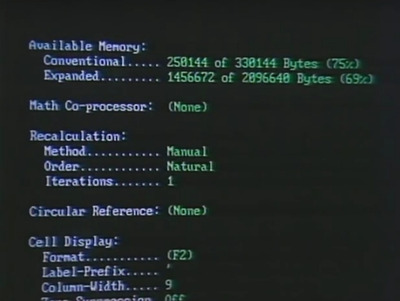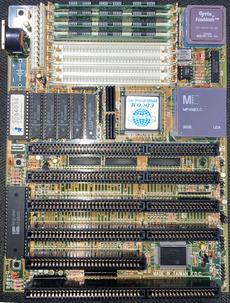the3dfxdude wrote on 2023-05-16, 21:47:
So yeah, most people with 286 still at that point were 1MB machines. Even the turbo XT I had before it was 1MB. So a 286 really was to run some office software faster, as the older games I had were too fast on a 286 at full speed. It could almost run Windows... but it sucked with 1MB.
Hi there! Thanks for the explanation, it makes sense.
I suppose that a few years earlier, in the 80s, when 8088 motherboards were still common,
users felt the urge to have a faster system.
An 8088 PC was dog slow, even with a Turbo mainboard.
That made the 80286 very attractive at the time. 8086 upgrades didn't really exist, it seems.
So users essentially ripped apart their existing XT PC and recycled as much as they could, including DIL/DIP RAM, drives and slow MFM hard disks..
Hm. Maybe it's also a country specific phenomenon:
In my place, users were a bit conservative. Their was a hesitation to replace something that works.
That's why 80286 PCs had a longer shelf life than in other places, I suppose.
I've seen ads for 286 PCs in 1992-1994, still.
There was simply no reason (no urge) to buy a 486 to most serious users (gamers and power users excluded).
For example, the 40 MHz AM386 was available in 1992, allowing for cheap, quick and reliable motherboards.
And not to say cute motherboards in a small form factor. ^^
They were a real success at the time (more about that later).
Now, how does this relate to 80286 PCs?
Well, the 80286 and 80386 use similar chipsets. They're not necessarily interchangeable, but the basic design is similar. The amount of external circuitry needed is roughly same.
Many 80386 chipsets evolved from 80286 chipsets.
The 80286 was not so far behind in terms of performance and support chips, also.
The small external cache made the 80386 seem faster, though.
The 80286 was also available as low-power version at the time, as 80L286.
Both 80286 and 386SX/DX had used 30pin SIMMs, for example, with similar access time (60 to 80 or 100ns).
To users in my country, the 80286 was not a bad choice, thus, I guess.
In 1992, both ran Windows 3.1 nicely and with full software support.
Both SVGA (if driver was Standard-Mode compatible) and audio/MCI were available in Standard-Mode.
Even Video for Windows ran on it at the time (VFW 1.0).
So there was no reason not to upgrade an 286 PC to run Windows properly.
RAM, and a better HDD, excluded, maybe. Having a computer mouse was also recommended.
A recent 80286 motherboard was no different to an 80386 motherboard, all in all.
The memory was invested well on either system.
In an 80286 system even more so, maybe, due to lack of virtual memory in Windows 3.1 Standard-Mode.
- On the other hand, Standard-Mode required less resources, also.
That's why Windows 3 started in Standard-Mode automatically, if a 386 had 2MB or less memory installed (unless forced with WIN /3). Touché.
PC repair books of the day covered 286 PCs, too. As if they were no different to 386/486 ones.
That's why my 286 PC ended up with 4MB, by the way. 1MB SIMMs with low latency were simply universally common.
On modern 286/386/486 systems of the time.
Before 486 PCs with DX2 or DX4 CPUs, VLB slots and 72pin SIMMs took off in ~1994.
By 1993, the situation started to change for 286 PCs, I think. More and more 32-Bit software appeared on market.
Which meant that a lot of 80286 PCs were either retrofitted with a 386 Baby-AT mainboard, or sold off cheaply.
Maybe exported to eastern Europe or Russia, maybe.
Here's a picture of a very modern 386 motherboard with high level of integration.
Source: https://theretroweb.com/motherboards/s/pcchips-m326-pga
It was often used as an easy upgrade for users of earlier systems.
It was one of the few occasions in which miniaturization was not affecting quality or functionality, I think.
Those little fellows were really solid, in terms of stability and build quality.
Edit: Some modern 80286 motherboards shipped with on-board VGA and ob-board floppy/IDE ports, even.
They could be spotted in 12 MHz or faster PCs of the time.
The 80286 had a life span of about 10 years in PC/AT compatibles (1984-1994).
That's why there are so much contradicting expectations, maybe.
Many people think of those old full-size boards with DIL/DIP RAM and 8 MHz ceramic CPU (LCC or PGA form factor).
But an early 90s 286 PC was a far cry from an ancient IBM PC/AT Model 5170 running at 6/8 MHz.
The BIOS and HDDs used had evolved significantly over the years.
The original NMOS fabrication process had switched to variations of CMOS process.
Last but not least, like its predecessor, the 80286 CPU was manufactured under license by several manufacturers, as well as being cloned a few times.
The situation was comparable to that of the Motorola 68000 CPU, maybe.
That amount of diversity was only topped by the 486 CPU, maybe.
The clone market for the 80486 CPUs was very profitable, I admit.
Edit: Here's a picture of a modern 80286 motherboard with integrated serial/parallel ports and ib-board VGA.
By the 1990s, this was a rather 'normal' 80286 motherboard, I think.
It's not a standard form factor model, though, of course. It's rather made for one of these proprietary, yet interesting PC systems of the time.
Source: Re: 286 USIT Athena PC


